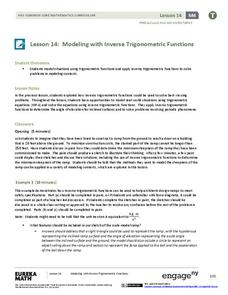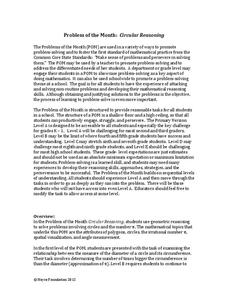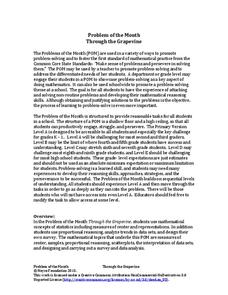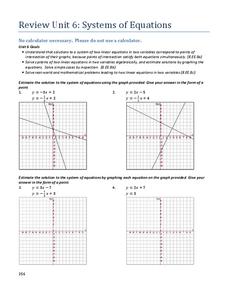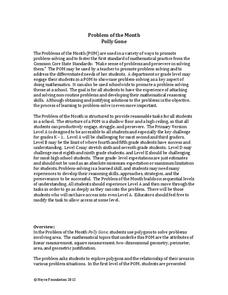EngageNY
Percent Increase and Decrease
Increase the percent of pupils that are fluent in solving change problems with an activity that asks class members to look at problems that involve either increases or decreases and to express the change in terms of the percent of...
EngageNY
Modeling with Inverse Trigonometric Functions 2
Use inverse trigonometric functions to work with ramps, rabbits, and Talladega. The class models real-world situations with trigonometric functions and solves them using inverses in the 15th installment of a 16-part series. Pupils solve...
Noyce Foundation
Digging Dinosaurs
Build a function to solve problems rooted in archeology. A comprehensive set of five lessons presents problems requiring individuals to use functions. The initial lesson asks learners to find the possible number of dinosaurs from a...
Noyce Foundation
Cut It Out
Explore the mathematics of the paper snowflake! During the five lessons progressing in complexity from K through 12, pupils use spatial geometry to make predictions. Scholars consider a folded piece of paper with shapes cut out....
Noyce Foundation
Circular Reasoning
Examine the origin and application of pi in five different levels. The five lessons in the resource begin with an analysis of the relationship between the radius and circumference of a circle. The following lessons lead learners through...
Noyce Foundation
On Balance
Investigate the world of unknown quantities with a creative set of five lessons that provides problem situations for varying grade levels. Each problem presents a scenario of fruit with different weights and a balance scale. Using the...
Noyce Foundation
Through the Grapevine
Teach statistics by analyzing raisins. A thorough activity provides lesson resources for five levels to include all grades. Younger pupils work on counting and estimation, mid-level learners build on their understanding of the measures...
EngageNY
Percent of a Quantity
Visualize methods of finding percents. Classmates find a percent of a quantity using two methods including a visual model in the 26th lesson in a series of 29. By the end of the lesson, scholars find percents given a part and the whole...
Charleston School District
Review Unit 6: Systems of Equations
It's time to show off what they learned! The final lesson in the series is a review worksheet on the topics learned throughout the unit. Scholars solve systems of equations using graphic and algebraic methods, solve system-based word...
Virginia Department of Education
Quadratic Equations
Review the multiple methods of solving quadratic equations through an analysis of the discriminant. Scholars use the discriminant to determine the best solution method and then solve various equations. As a challenge, learners build...
Noyce Foundation
Surrounded and Covered
What effect does changing the perimeter have on the area of a figure? The five problems in the resource explore this question at various grade levels. Elementary problems focus on the perimeter of rectangles and irregular figures with...
Noyce Foundation
Poly-Gone
Investigate polygons from rectangles to triangles to octagons. Each level of the five-problem series targets a different grade level. Beginning with the level A problem, learners examine the relationship between area and perimeter by...
EngageNY
Nature of Solutions of a System of Linear Equations
If at first you cannot graph, substitute. The lesson introduces the substitution method as a way to solve linear systems if the point of intersection is hard to determine from a graph. The 28th installment of a 33-part series finishes...
EngageNY
Getting the Job Done—Speed, Work, and Measurement Units II
How fast is your class? Learners determine the amount of time it takes individuals to walk a given distance and calculate their speeds. Pupils solve distance, rate, and time problems using the formula and pay attention to the...
Curated OER
Multiplication and Division Word Problems
Give your mathematicians some multiplication and division practice using these visual word problems. The three short scenarios are each accompanied by a visual guide, however think twice before letting learners use them. The first one...
Education Development Center
Making Sense of Unusual Results
Collaboration is the key for this equation-solving lesson. Learners solve a multi-step linear equation that requires using the distributive property. Within collaborative groups, scholars discuss multiple methods and troubleshoot mistakes.
Super Teacher Worksheets
Improper Fractions & Mixed Numbers
Young mathematicians demonstrate their understanding of part-whole relationships in a fraction skills worksheet. Presented with a series of mixed numbers and improper fractions, learners must correctly convert each of them into...
Curated OER
Addition and Subtraction Word Problems Guided Lesson
Using visuals helps young mathematicians grasp concepts such as addition and subtraction. Here, they use just that to solve three scenarios. In the first scenario, three turtles leave a group of five, and learners determine how many...
Curated OER
Identify Coins
Kill two birds with one stone (as they say). Your class can practice problem solving skills, basic addition and subtraction, as well as work on coin values. This learning exercise includes six money related word problems to solve.
Curated OER
Model Equivalent Fractions: Number Lines or Fraction Strips
In this model equivalent fractions instructional activity, students sharpen their problem solving skills as they solve 6 story problems.
Curated OER
Solving Inequalities
This is a nice activity on solving one variable and compound inequalities. Learners solve inequalities and graph the solution on a number line. The two page activity contains explanation and sixteen practice problems.
Curated OER
Leveled Problem Solving Scale Drawings and Models
In this scale drawings activity, 5th graders learn to solve measurement problems using scale drawings and models for the six word problems.
Curated OER
Problem-Solving Application: Comparing Prices
In this problem solving worksheet, students solve 3 problems pertaining to comparing prices in a museum gift shop. Students find the most economical way to buy specified items..
Curated OER
Problem-Solving Strategy: Work Backward
In this problem solving worksheet, students solve two word problems that require them to work backward to find the original number. There is an example provided.

